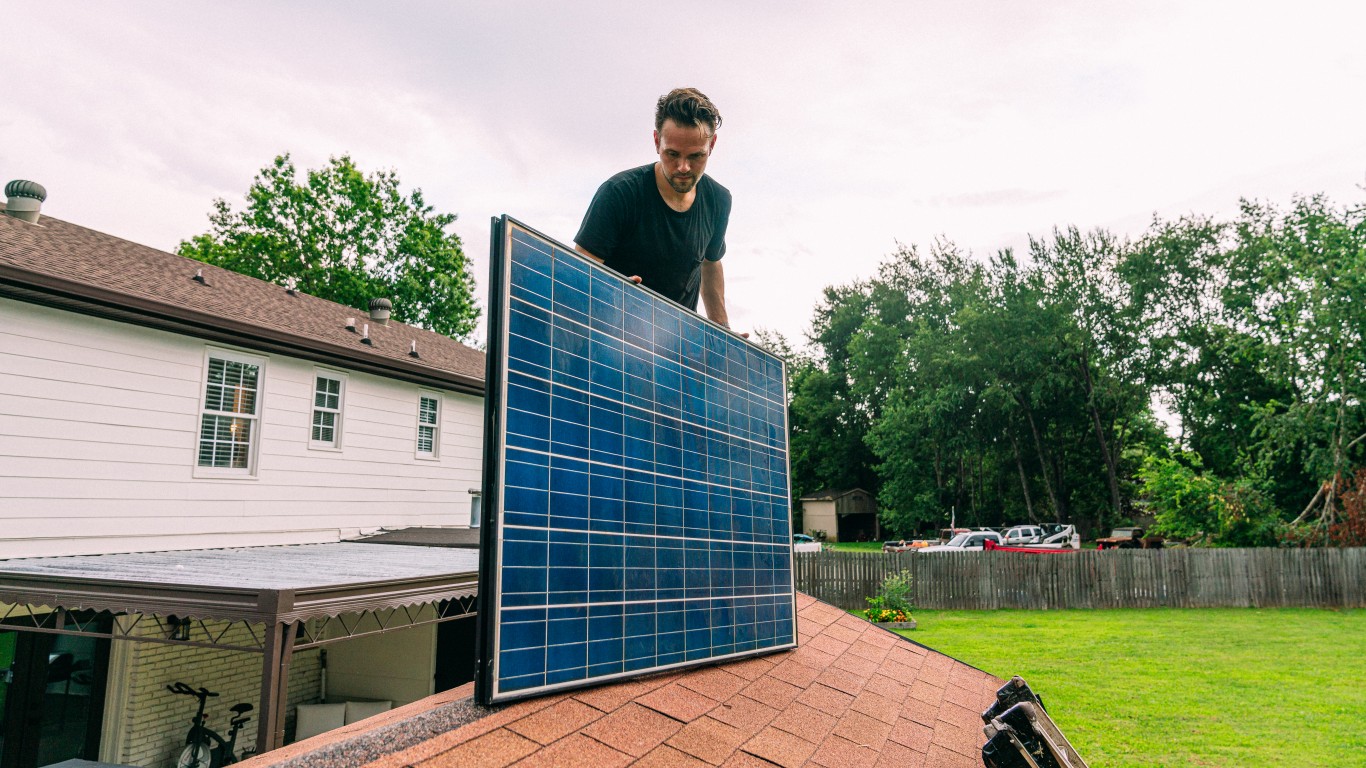
From an economic standpoint, the United States has changed profoundly in the last 10 years. Emerging from a devastating recession in 2009, gross domestic product increased nearly 19% since, and the economy has added jobs for an unprecedented 101 consecutive months. These welcome developments have had a meaningful impact on the lives of everyday Americans as real personal income per capita — a measure that accounts for inflation — climbed 14.3%, from $43,431 in 2008 to $49,627 in 2018.
While the United States is a wealthier nation than it was a decade ago, income growth has not been evenly spread geographically. In some states, the 10-year increase in real personal income far exceeds the 14.3% national growth over that time.
24/7 Wall St. calculated change in real personal income per capita from 2008 to 2018 to identify the states where incomes are booming. In most of these states, faster than average employment growth and strong GDP growth underpin the rapid increase in purchasing power.
It is important to note that an increase in per-capita purchasing power in a state does not necessarily mean all residents are benefitting equally. Real personal income includes sources like capital gains, and often, capital growth disproportionately benefits the highest earners, exacerbating the problem of income inequality and, in some states, the erosion of the middle class. Additionally, increase in income is relative, and some of these states, despite nation-leading increases in income per capita, still rank among the poorest in the country.
Click here to see the 13 states where incomes are booming
Methodology
To identify the 13 states where incomes are booming, 24/7 Wall St. calculated the percentage growth in real personal income per capita from 2008 to 2018. RPI for 2017 and 2018 were calculated using the 2016 regional price parity, personal income figures, and the personal consumption expenditure price index, in accordance with the methodology provided by the Bureau of Labor Statistics. RPP, PCEPI, RPI, and real gross domestic product in chained 2012 dollars came from the Bureau of Economic Analysis. The fastest-growing industry in each state, as well as data on labor force and unemployment, was derived from the BLS. Total population, population change, household income, and poverty rates were derived from the U.S Census Bureau’s 2017 American Community Survey.
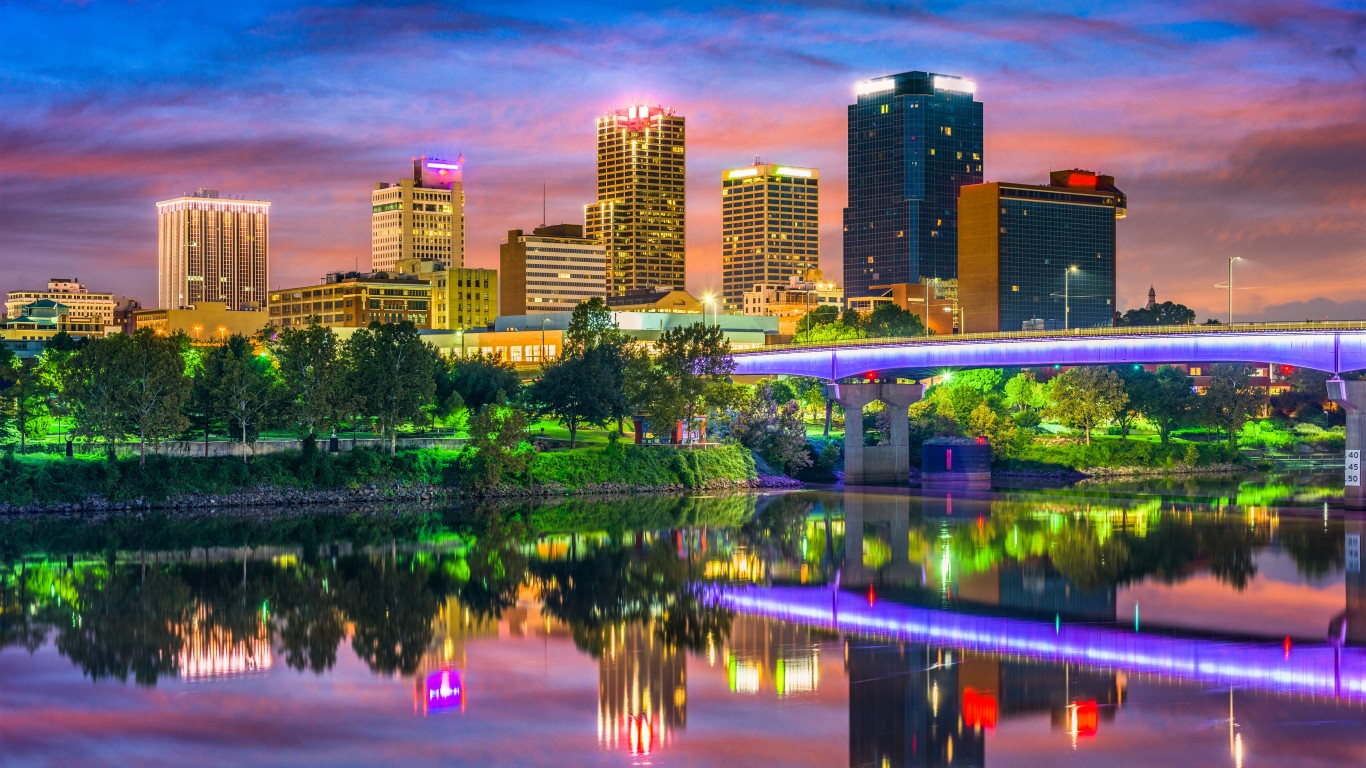
13. Arkansas
> Personal income per capita growth (2008-2018): +16.0%
> Personal income per capita: $39,329 (6th lowest)
> Employment growth (2008-2018): 0.1% (the smallest increase)
> GDP growth (2008-2017): 7.7% (15th smallest increase)
Real personal income per capita climbed 16.0% in Arkansas in the last 10 years, from $33,908 in 2008 to $39,329 in 2018. Climbing incomes are having a meaningful impact on the quality of life of many in the state. In the last five years alone, the share of residents living below the poverty line fell from 19.8% to 16.4%. Additionally, the state is home to a growing share of wealthy residents. The share of households earning $200,000 or more annually climbed to 3.0% in 2017 from 2.0% in 2012.
Despite the rapid economic gains in recent years, Arkansas remains among the poorest states in the country.
See all stories featuring: Arkansas
[in-text-ad]

12. Utah
> Personal income per capita growth (2008-2018): +16.0%
> Personal income per capita: $41,892 (10th lowest)
> Employment growth (2008-2018): 15.2% (4th largest increase)
> GDP growth (2008-2017): 21.5% (5th largest increase)
Utah has one of the fastest growing economies in the country. The state’s GDP climbed by 21.5% between 2008 and 2017, faster than all but four other states. Similarly, the state’s labor force expanded by 14.7% over roughly the same period. Job growth more than kept pace with demand for work, as the state’s unemployment rate fell to 3.1% in 2018 from 3.6% in 2008.
Against the backdrop of a booming economy and strong job market, incomes and purchasing power have also climbed in Utah. Personal income per capita in Utah was $41,892 in 2018, up 16% from $36,111 in 2008.
See all stories featuring: Utah

11. Montana
> Personal income per capita growth (2008-2018): +16.3%
> Personal income per capita: $43,536 (17th lowest)
> Employment growth (2008-2018): 5.2% (24th largest increase)
> GDP growth (2008-2017): 10.6% (23rd largest increase)
Real personal income, indicative of purchasing power, increased by 16.3% in Montana over the last decade — more than in all but 10 other states and well above the 14.3% national increase over that time. Income growth in the state was supported by steady job growth. The annual unemployment rate fell from a post-recession peak of 7.3% in 2010 to 3.7% in 2018, one of the lower unemployment rates among states.
The climbing incomes in Montana may partially be attributable to a better educated workforce. College-educated adults typically earn more than workers with just a high school diploma, and the share of adults with a bachelor’s degree in the state climbed from 29.4% in 2012 to 32.3% in 2017.
See all stories featuring: Montana

10. Michigan
> Personal income per capita growth (2008-2018): +16.3%
> Personal income per capita: $43,963 (19th lowest)
> Employment growth (2008-2018): 3.7% (15th smallest increase)
> GDP growth (2008-2017): 10.1% (25th largest increase)
Real personal income per capita climbed by 16.3% in Michigan between 2008 and 2018 — well above the 14.3% national increase. Over roughly the same period, the share of households in the state earning less than $10,000 a year fell from 8.7% to 6.8%, and the state’s poverty rate also fell faster than average, from 17.4% to 14.2%.
Michigan is one of the few states on this list to report a net outward migration in the last eight years. Between 2010 and 2018, 53,000 more people moved out of the state than moved in.
See all stories featuring: Michigan
[in-text-ad-2]
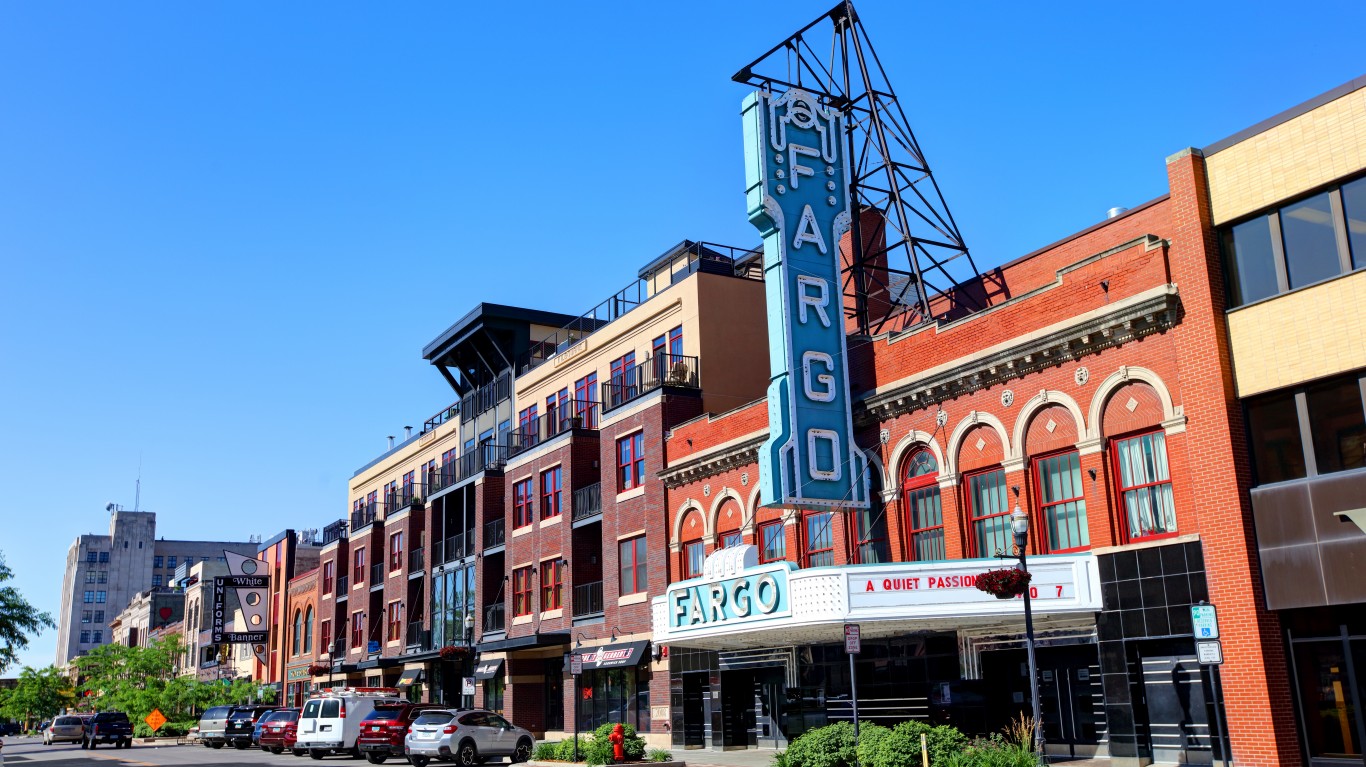
9. North Dakota
> Personal income per capita growth (2008-2018): +16.3%
> Personal income per capita: $50,176 (18th highest)
> Employment growth (2008-2018): 9.6% (15th largest increase)
> GDP growth (2008-2017): 48.7% (the largest increase)
Real personal income per capita climbed by 16.3% in North Dakota in the last decade, more than in all but eight other states. The rapid real personal income growth in North Dakota was driven in part by the state’s oil boom, fueled by hydrofracking in the western part of the state. Thanks to new drilling technologies, which provided access petroleum in the state’s Bakken shale formation, the state produced over 40 million barrels of oil in 2018, nearly eight times the amount it produced in 2008. Meanwhile, employment in the state’s mining and logging industry spiked by over 200%, and the state’s GDP expanded a nation-leading 48.7%.
See all stories featuring: North Dakota

8. Colorado
> Personal income per capita growth (2008-2018): +16.4%
> Personal income per capita: $52,522 (13th highest)
> Employment growth (2008-2018): 15.8% (3rd largest increase)
> GDP growth (2008-2017): 20.8% (6th largest increase)
Colorado has one of the fastest growing economies in the country. Since 2008, Colorado’s GDP climbed by 20.8%, a larger increase than all but five other states and well above the 15.7% national GDP growth over that time. The growing economy has led to greater purchasing power for state residents. Per-capita real personal income climbed by 16.4% over roughly the same period, the eighth greatest increase among states.
For both individuals and broad workforces, incomes generally rise with educational attainment. In Colorado, the share of adults who hold a bachelor’s degree or higher increased from 37.5% as recently as 2012 to 41.2% — currently the second largest share of any state.
See all stories featuring: Colorado
[in-text-ad]

7. New Hampshire
> Personal income per capita growth (2008-2018): +16.4%
> Personal income per capita: $56,735 (7th highest)
> Employment growth (2008-2018): 4.0% (25th largest increase)
> GDP growth (2008-2017): 14.4% (16th largest increase)
Real personal income per capita shot up by 16.4% in New Hampshire over the last decade. The spike likely helped push many in the state into higher-income brackets. Currently, 8.3% of New Hampshire households earn $200,000 or more a year, up substantially from 5.1% of households as recently as 2012.
New Hampshire’s fastest growing industry by employment over the last decade was professional and business services. Employment in the industry, which is generally high paying, climbed by 24.9% between 2008 and 2018.
See all stories featuring: New Hampshire
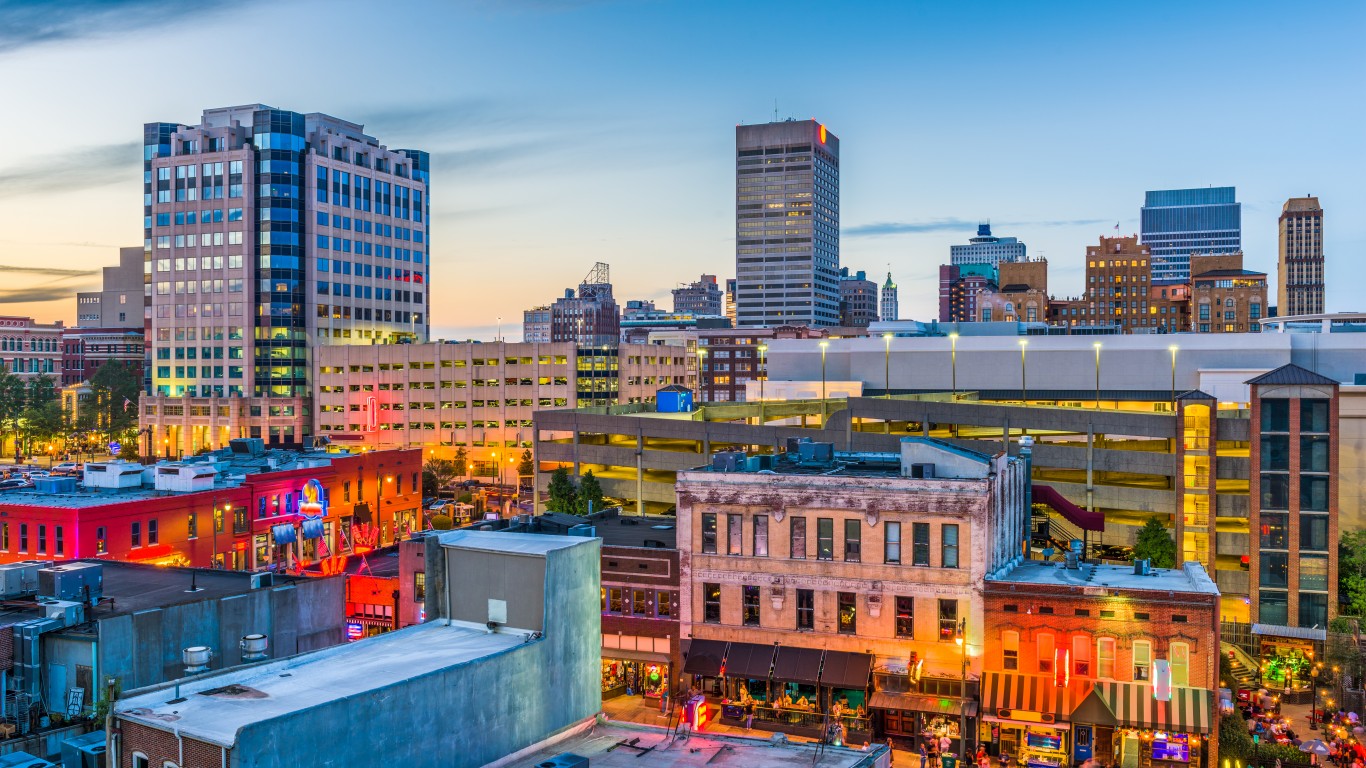
6. Tennessee
> Personal income per capita growth (2008-2018): +17.2%
> Personal income per capita: $43,591 (18th lowest)
> Employment growth (2008-2018): 9.7% (14th largest increase)
> GDP growth (2008-2017): 15.9% (12th largest increase)
Tennessee is one of six states where real personal income per capita increased by more than 17% in the last 10 years. The greater purchasing power was boosted in part by an employment surge in the state’s professional and business services industry. The number of people working in the industry — which is higher paying than most — climbed by 28.3% between 2008 and 2018, the most of any industry in the state.
Climbing incomes have had a meaningful effect in improving the quality of life of many of Tennessee’s poorest residents. In the last five years alone, the state’s poverty rate fell from 17.9% to 15.0%.
See all stories featuring: Tennessee

5. Oregon
> Personal income per capita growth (2008-2018): +17.3%
> Personal income per capita: $46,112 (25th highest)
> Employment growth (2008-2018): 10.4% (11th largest increase)
> GDP growth (2008-2017): 19.4% (8th largest increase)
Personal income per capita climbed 17.3% in Oregon between 2008 and 2018, the fifth largest increase of any state. Partially as a result, the state reported a near-leading reduction of poverty. As recently as 2012, Oregon’s poverty rate of 17.2% was well above the national poverty rate of 15.9%. As of 2017, the most recent year for which data is available, Oregon’s poverty rate of 13.2% was slightly below the national rate of 13.4%. The 4 percentage point decline in the poverty rate was the third largest improvement of any state.
The rising incomes in the state are likely partly the result of a climbing bachelor’s degree attainment rate. Better-educated Americans typically earn higher incomes, and the share of college-educated adults in Oregon climbed to 33.7% from 29.9% in just the last five years.
See all stories featuring: Oregon
[in-text-ad-2]

4. Massachusetts
> Personal income per capita growth (2008-2018): +17.6%
> Personal income per capita: $64,744 (2nd highest)
> Employment growth (2008-2018): 12.8% (6th largest increase)
> GDP growth (2008-2017): 18.8% (10th largest increase)
Massachusetts is the most educated state in the country — and the state’s college-educated population is also the fastest growing in the country. Currently, 43.4% of adults in the state have a bachelor’s degree or higher, up by a nation leading 4.1 percentage points since 2012. For reference, the share of adults with a bachelor’s degree nationwide climbed 2.9 percentage points in the last five years to 32.0%.
Incomes typically rise with educational attainment, and in Massachusetts, real personal income per capita jumped by 17.6% since 2008, the fourth largest increase among states.
See all stories featuring: Massachusetts

3. Washington
> Personal income per capita growth (2008-2018): +18.7%
> Personal income per capita: $56,158 (8th highest)
> Employment growth (2008-2018): 10.1% (13th largest increase)
> GDP growth (2008-2017): 25.8% (3rd largest increase)
Washington’s near-nation-leading 18.7% increase in personal income per capita in the last 10 years was supported by equally sharp economic growth. The state’s GDP climbed by 25.8% between 2008 and 2017, the third largest growth after only Texas and North Dakota.
Washington’s economy is largely supported by the presence of a handful of major companies, including tech giants Amazon and Microsoft and food services company Costco — each of which ranks among the top 30 Fortune 500 companies.
See all stories featuring: Washington
[in-text-ad]

2. New York
> Personal income per capita growth (2008-2018): +23.8%
> Personal income per capita: $63,445 (3rd highest)
> Employment growth (2008-2018): 0.5% (4th smallest increase)
> GDP growth (2008-2017): 20.3% (7th largest increase)
Personal income per capita in New York climbed by a staggering 23.8% between 2008 and 2018 — the second largest increase of any state, far outpacing the 14.3% national increase over the same time.
New York City is the center of American finance, and the climbing incomes across the state are likely partially attributable to capital gains as the United States marked its longest bull market in history in August 2018. Income from investments in stocks and bonds disproportionately benefit wealthy Americans, and in the last 10 years, the share of New York households earning at least $200,000 a year climbed from 6.6% to 9.8%.
See all stories featuring: New York
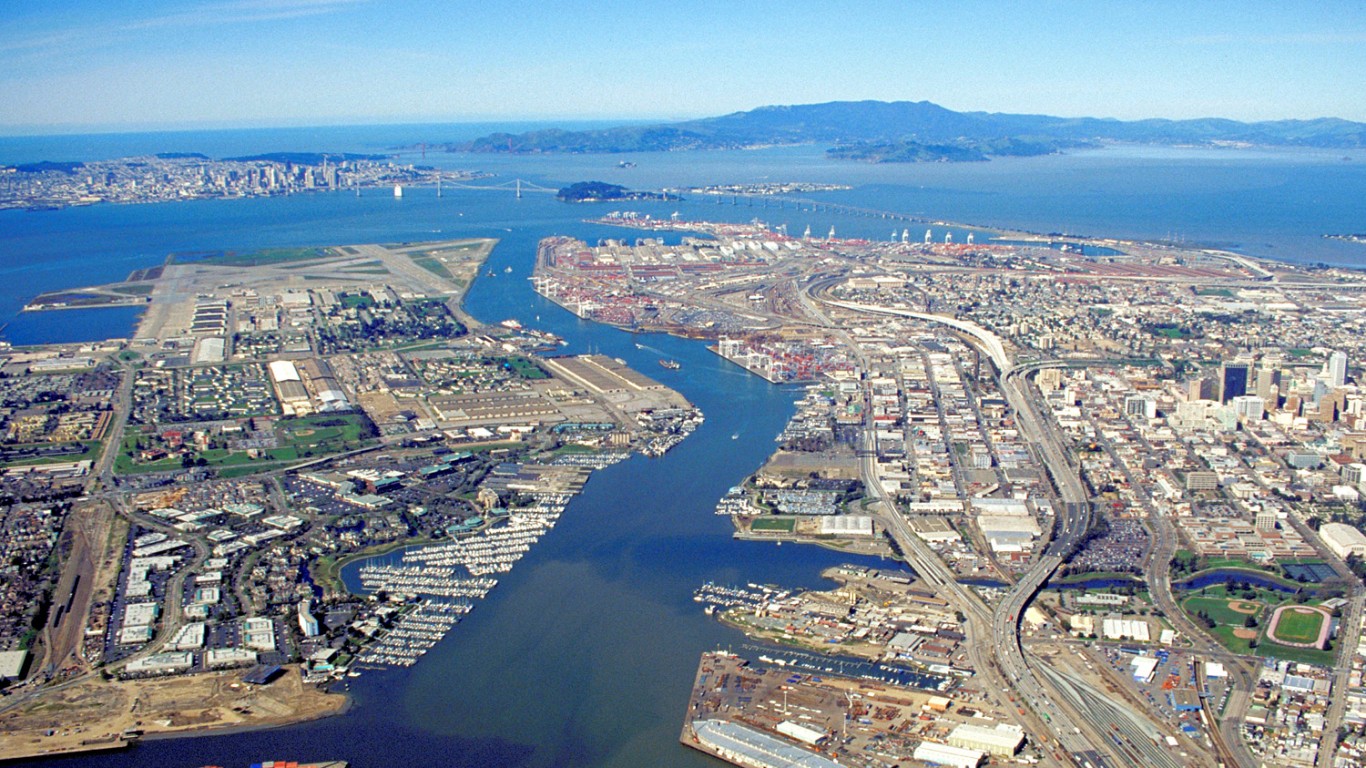
1. California
> Personal income per capita growth (2008-2018): +24.1%
> Personal income per capita: $57,826 (6th highest)
> Employment growth (2008-2018): 10.3% (12th largest increase)
> GDP growth (2008-2017): 22.0% (4th largest increase)
Real income per capita climbed by 24.1% in California in the last decade, the largest increase of any state and nearly 10 percentage points above personal income growth nationwide over that time. Over roughly the same period, the state’s GDP spiked by 22.0%, more than all but three other states. Income growth in California pushed many in the state into higher income brackets. The share of households earning $200,000 or more climbed from 6.8% just in 2012 to 11.1% in 2017.
California’s diverse economy is the largest in the United States and the fifth largest in the world. The state is home to the headquarters of some of the largest U.S. companies, including Apple, Alphabet — Google’s parent company — and Wells Fargo, each of which ranks among the top 30 Fortune 500 firms.
See all stories featuring: California
The Average American Has No Idea How Much Money You Can Make Today (Sponsor)
The last few years made people forget how much banks and CD’s can pay. Meanwhile, interest rates have spiked and many can afford to pay you much more, but most are keeping yields low and hoping you won’t notice.
But there is good news. To win qualified customers, some accounts are paying almost 10x the national average! That’s an incredible way to keep your money safe and earn more at the same time. Our top pick for high yield savings accounts includes other benefits as well. You can earn up to 3.80% with a Checking & Savings Account today Sign up and get up to $300 with direct deposit. No account fees. FDIC Insured.
Click here to see how much more you could be earning on your savings today. It takes just a few minutes to open an account to make your money work for you.
Our top pick for high yield savings accounts includes other benefits as well. You can earn up to 4.00% with a Checking & Savings Account from Sofi. Sign up and get up to $300 with direct deposit. No account fees. FDIC Insured.
Thank you for reading! Have some feedback for us?
Contact the 24/7 Wall St. editorial team.
 24/7 Wall St.
24/7 Wall St. 24/7 Wall St.
24/7 Wall St.
